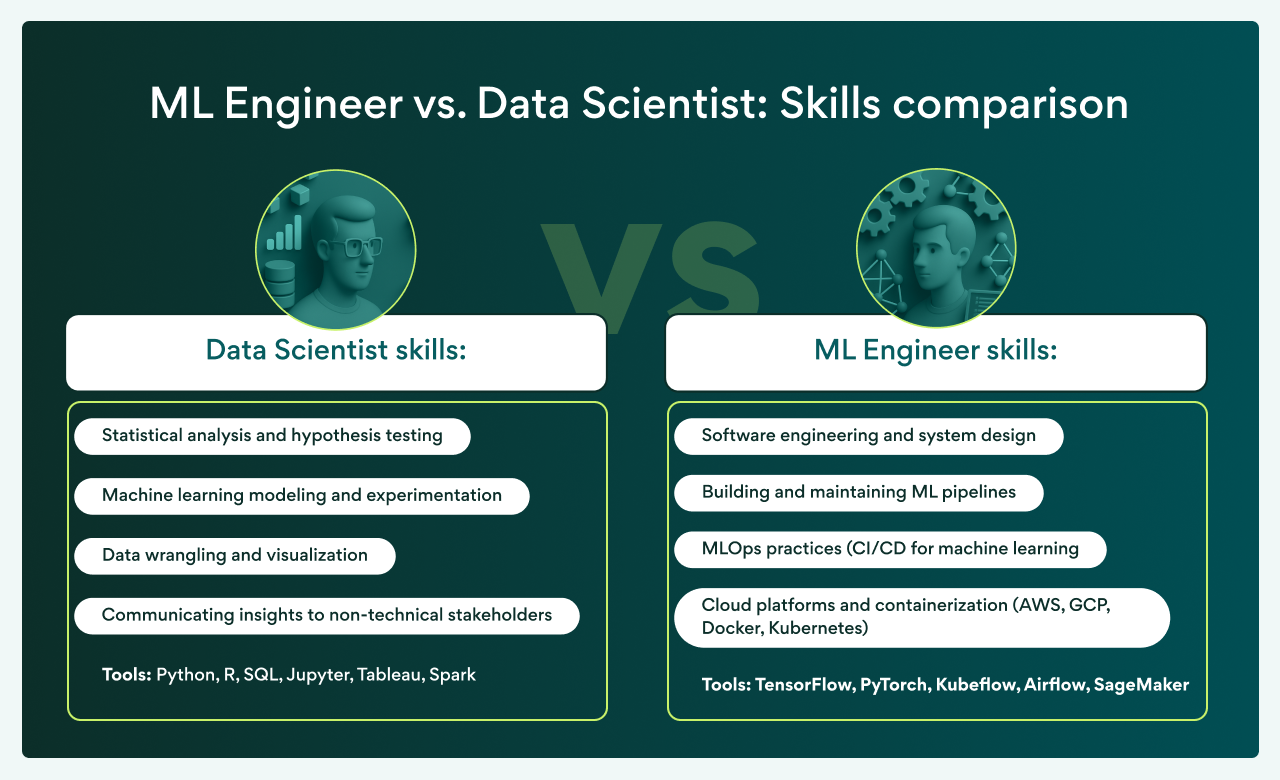



A Data Scientist is often described as a “storyteller with data.” Their primary focus is to extract insights from raw information and translate them into strategies that guide decision-making. Unlike engineers, who are responsible for building and maintaining systems, Data Scientists concentrate on asking the right questions and finding patterns that reveal meaningful answers.
At the core of their work is data exploration: collecting, cleaning, and analyzing datasets to understand trends or anomalies. They design predictive and statistical models, test their hypotheses, and run experiments to confirm or challenge assumptions. For example, a Data Scientist might help a retailer forecast customer demand, identify segments with the highest lifetime value, or determine why customer churn is increasing.
Tools of the trade: Python, R, SQL, Jupyter Notebooks, visualization libraries (Matplotlib, Seaborn), and platforms like Spark or TensorFlow when deeper machine learning is required.
In essence, Data Scientists transform raw data into insights that drive business strategy. Their impact lies in helping organizations understand the “why” behind the numbers—a foundation that enables smarter decisions and sets the stage for ML Engineers to build scalable solutions.
You may often see job titles like Machine Learning Engineer and Data Scientist everywhere, from LinkedIn profiles to hiring ads. Yet, many companies and even professionals themselves are unsure where one role ends and the other begins. Both work with data, both apply machine learning, and both are vital in shaping modern businesses. However, their focus, skill sets, and impact can be very different.
For businesses, choosing the right expertise can determine whether a project delivers real value or stalls in experimentation. And for professionals, knowing how the roles diverge can help shape a more intentional and rewarding career path.
So, what exactly sets an ML Engineer apart from a Data Scientist? And which role does your team actually need? Let’s break it down.
If a Data Scientist is the one who uncovers insights, an ML Engineer is the one who brings those insights to life in the real world. Their role focuses on taking machine learning models out of notebooks and experiments, and making them run reliably at scale in production environments.
ML Engineers combine expertise in machine learning with strong software engineering skills. They ensure that models don’t just work in theory but integrate seamlessly into applications, products, and systems that thousands or even millions of users can depend on.
Tools of the trade: Python, Java, or C++; ML frameworks like TensorFlow or PyTorch; orchestration tools such as Airflow or Kubeflow; and cloud platforms like AWS SageMaker, Google Vertex AI, or Azure ML.
Where Data Scientists focus on what a model can tell us, ML Engineers focus on how to make it useful and sustainable at scale. In essence, they are the bridge between research and production, ensuring AI initiatives move from experimental prototypes to real-world impact.

You may often see job titles like Machine Learning Engineer and Data Scientist everywhere, from LinkedIn profiles to hiring ads. Yet, many companies and even professionals themselves are unsure where one role ends and the other begins. Both work with data, both apply machine learning, and both are vital in shaping modern businesses. However, their focus, skill sets, and impact can be very different.
For businesses, choosing the right expertise can determine whether a project delivers real value or stalls in experimentation. And for professionals, knowing how the roles diverge can help shape a more intentional and rewarding career path.
So, what exactly sets an ML Engineer apart from a Data Scientist? And which role does your team actually need? Let’s break it down.
A Data Scientist is often described as a “storyteller with data.” Their primary focus is to extract insights from raw information and translate them into strategies that guide decision-making. Unlike engineers, who are responsible for building and maintaining systems, Data Scientists concentrate on asking the right questions and finding patterns that reveal meaningful answers.
At the core of their work is data exploration: collecting, cleaning, and analyzing datasets to understand trends or anomalies. They design predictive and statistical models, test their hypotheses, and run experiments to confirm or challenge assumptions. For example, a Data Scientist might help a retailer forecast customer demand, identify segments with the highest lifetime value, or determine why customer churn is increasing.
Tools of the trade: Python, R, SQL, Jupyter Notebooks, visualization libraries (Matplotlib, Seaborn), and platforms like Spark or TensorFlow when deeper machine learning is required.
In essence, Data Scientists transform raw data into insights that drive business strategy. Their impact lies in helping organizations understand the “why” behind the numbers—a foundation that enables smarter decisions and sets the stage for ML Engineers to build scalable solutions.
If a Data Scientist is the one who uncovers insights, an ML Engineer is the one who brings those insights to life in the real world. Their role focuses on taking machine learning models out of notebooks and experiments, and making them run reliably at scale in production environments.
ML Engineers combine expertise in machine learning with strong software engineering skills. They ensure that models don’t just work in theory but integrate seamlessly into applications, products, and systems that thousands or even millions of users can depend on.
Tools of the trade: Python, Java, or C++; ML frameworks like TensorFlow or PyTorch; orchestration tools such as Airflow or Kubeflow; and cloud platforms like AWS SageMaker, Google Vertex AI, or Azure ML.
Where Data Scientists focus on what a model can tell us, ML Engineers focus on how to make it useful and sustainable at scale. In essence, they are the bridge between research and production, ensuring AI initiatives move from experimental prototypes to real-world impact.
As described above, both roles work with data and machine learning, but their focus, deliverables, and day-to-day work look quite different. Here’s a side-by-side comparison showing where Data Scientist and ML Engineer roles overlap and where they differ.
Together, these roles are complementary: Data Scientists explore and model data to generate insights, while ML Engineers ensure those models are robust enough to power real-world products and services.
While Data Scientists and ML Engineers often share a foundation in mathematics, programming, and machine learning, the paths they take in their careers tend to diverge. Understanding these differences is key for both professionals considering their next career step and businesses deciding which role to hire
Many Data Scientists come from backgrounds in mathematics, statistics, or research-heavy fields. Their career trajectory often begins with roles in data analysis or academic research, then evolves into applied machine learning and advanced analytics. Over time, experienced Data Scientists may move into leadership positions such as Lead Data Scientist, Head of Analytics, or even Chief Data Officer.
ML Engineers often come from software engineering or computer science backgrounds. They may begin as software developers or backend engineers before specializing in machine learning infrastructure and deployment. As their expertise grows, they can move into senior roles including Senior ML Engineer, ML Architect, or Head of AI Engineering.

When it comes to ML Engineer vs. Data Scientist salary, the gap is narrowing, but engineers usually command slightly higher salaries due to their strong software engineering background and expertise in production-ready systems.
Both roles share knowledge of machine learning algorithms, data handling, and Python programming. However, while Data Scientists emphasize research and insight generation, ML Engineers emphasize system integration and scalability.
Both Data Scientists and ML Engineers play critical roles in building AI-powered organizations, but the right choice depends on your goals. If your business needs to explore data, uncover insights, and build experimental models, a Data Scientist is the right fit. If your focus is on scaling those models, integrating them into products, and ensuring long-term reliability, you’ll need an ML Engineer.
For many companies, the answer isn’t one or the other—it’s both. Data Scientists generate the insights and models that guide strategy, while ML Engineers ensure those models deliver measurable impact in the real world. Together, these roles form the backbone of effective AI teams. Choosing wisely not only speeds up innovation but also maximizes the return on AI investments.
Need help building a high-performing AI team? Contact us to hire vetted Data Scientists and ML Engineers.
You may often see job titles like Machine Learning Engineer and Data Scientist everywhere, from LinkedIn profiles to hiring ads. Yet, many companies and even professionals themselves are unsure where one role ends and the other begins. Both work with data, both apply machine learning, and both are vital in shaping modern businesses. However, their focus, skill sets, and impact can be very different.
For businesses, choosing the right expertise can determine whether a project delivers real value or stalls in experimentation. And for professionals, knowing how the roles diverge can help shape a more intentional and rewarding career path.
So, what exactly sets an ML Engineer apart from a Data Scientist? And which role does your team actually need? Let’s break it down.